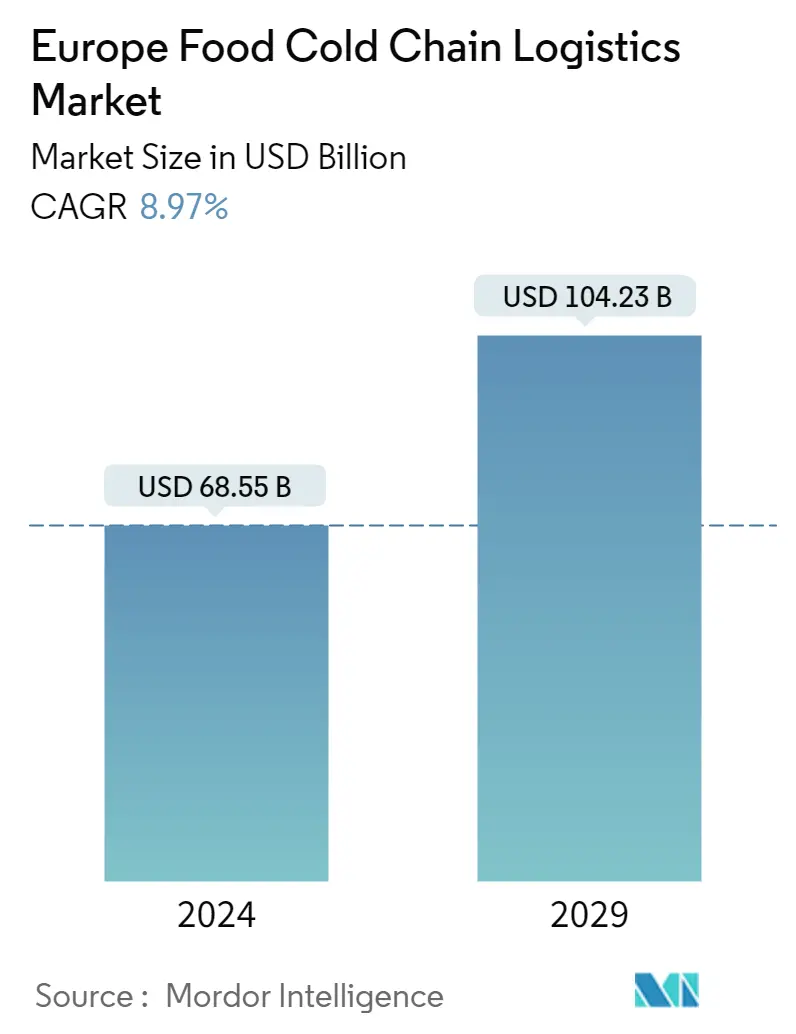Market Size of Europe Food Cold Chain Logistics Industry

| Study Period | 2019 - 2029 |
| Base Year For Estimation | 2023 |
| Market Size (2024) | USD 68.55 Billion |
| Market Size (2029) | USD 104.23 Billion |
| CAGR (2024 - 2029) | 8.97 % |
| Market Concentration | Medium |
Major Players
*Disclaimer: Major Players sorted in no particular order |
Need a report that reflects how COVID-19 has impacted this market and its growth?
Europe Food Cold Chain Logistics Market Analysis
The Europe Food Cold Chain Logistics Market size is estimated at USD 68.55 billion in 2024, and is expected to reach USD 104.23 billion by 2029, growing at a CAGR of 8.97% during the forecast period (2024-2029).
In Europe, the market for cold chain services is expanding rapidly. A shift in the region's eating preferences has been a fundamental driver of the cold chain business in Europe.
The demand for fresh fruits and vegetables has steadily increased in Europe due to changes in consumer preferences and growth in health consequences. This led to an increase in the production and trade of fruits & vegetables, creating a need for efficient coal chain logistics. In addition, stringent regulations regarding food safety and quality standards have necessitated the use of cold chain logistics.
In January 2021, the European Union introduced new regulations to improve the quality and safety of organic products, which would impact the cold chain logistics for organic fruits and vegetables.
According to the Centre for the Promotion of Imports from Developing Countries (CBI), Europe has a population of more than 530 million consumers, and it accounted for more than USD 68.13 billion (EUR 62 billion), or 43% of the total global trade value of fresh fruit and vegetables in December 2022.
In addition, the European Union imported vegetable, fruit, and nut food preparations worth USD 6.96 billion in the year 2022, according to the United Nations COMTRADE database.
Furthermore, there has been an increase in focus on sustainability and reduction in the carbon footprint of cold chain logistics, leading to the development of eco-friendly solutions for preserving fruits and vegetables.
Europe Food Cold Chain Logistics Industry Segmentation
Transport and storage of non-perishable goods requiring controlled and low-temperature conditions (e.g., art objects) are usually not considered a Food Cold Chain. The Food Cold Chain includes various perishable products: fresh agricultural, frozen, and seafood.
A comprehensive background analysis of the European food Cold Chain Logistics Market, covering the current market trends, restraints, technological updates, and detailed information on various segments and the competitive landscape of the industry. The impact of COVID-19 has also been incorporated and considered during the study.
The European food cold chain logistics market is segmented by application (fruits and vegetables, meat and seafood, dairy and frozen dessert, bakery and confectionery, ready-to-eat meal, and other applications), by service type (refrigerated storage, refrigerated transport, airways, roadways, seaways, railways), by geography (France, Germany, Italy, Russia, Spain, United Kingdom, rest of Europe).
The report offers market size and forecasts for the European food cold chain logistics market in value (USD) for all the above segments.
| By Application | |
| Fruits and Vegetables | |
| Meat and Seafood | |
| Dairy and Frozen Dessert | |
| Bakery and Confectionery | |
| Ready-to-Eat Meal | |
| Other Applications |
| By Service Type | |
| Refrigerated Storage | |
| Refrigerated Transport | |
| Airways | |
| Roadways | |
| Seaways | |
| Railways |
| Geography | |||||||||
|
Europe Food Cold Chain Logistics Market Size Summary
The Europe Food Cold Chain Logistics Market is experiencing significant growth, driven by evolving consumer preferences and stringent food safety regulations. The increasing demand for fresh produce, coupled with the rise of e-commerce, has necessitated advanced cold chain logistics solutions to ensure the quality and safety of perishable goods. The market is characterized by a mix of global and regional players, with companies like Americold Logistics and Lineage Logistics leading the charge. The focus on sustainability and reducing carbon footprints is also shaping the industry, as companies develop eco-friendly solutions to meet consumer and regulatory demands.
Germany stands out as a key player in the European cold chain logistics sector, being a major importer and exporter of agricultural and processed food products. The market is highly fragmented, offering opportunities for both new and established firms to expand their presence. Recent developments, such as Lineage Logistics' acquisition of a facility in Belgium, highlight the ongoing efforts to enhance capacity and service offerings across Europe. Additionally, initiatives like the EU-funded ICCEE project aim to improve the technological capabilities of small and medium-sized enterprises, further bolstering the region's cold chain logistics infrastructure.
Europe Food Cold Chain Logistics Market Size - Table of Contents
-
1. MARKET DYNAMICS
-
1.1 Market Overview
-
1.2 Market Drivers
-
1.2.1 The rising consumption of frozen food
-
1.2.2 Increasing Demand of Refrigerated Logistics from the Retail Industry
-
-
1.3 Market Restraints
-
1.3.1 Poor infrastructure and higher logistics costs
-
-
1.4 Market Oppurtunities
-
1.4.1 Surge in use of IT solutions & automated software for cold chain logistics.
-
-
1.5 Value Chain / Supply Chain Analysis
-
1.6 Porter's Five Forces Analysis
-
1.6.1 Bargaining Power of Suppliers
-
1.6.2 Bargaining Power of Buyers/Consumers
-
1.6.3 Threat of New Entrants
-
1.6.4 Threat of Substitute Products
-
1.6.5 Intensity of Competitive Rivalry
-
-
1.7 Impact of COVID-19 on the market
-
-
2. MARKET SEGMENTATION
-
2.1 By Application
-
2.1.1 Fruits and Vegetables
-
2.1.2 Meat and Seafood
-
2.1.3 Dairy and Frozen Dessert
-
2.1.4 Bakery and Confectionery
-
2.1.5 Ready-to-Eat Meal
-
2.1.6 Other Applications
-
-
2.2 By Service Type
-
2.2.1 Refrigerated Storage
-
2.2.2 Refrigerated Transport
-
2.2.3 Airways
-
2.2.4 Roadways
-
2.2.5 Seaways
-
2.2.6 Railways
-
-
2.3 Geography
-
2.3.1 Europe
-
2.3.1.1 Germany
-
2.3.1.2 United Kingdom
-
2.3.1.3 France
-
2.3.1.4 Italy
-
2.3.1.5 Russia
-
2.3.1.6 Spain
-
2.3.1.7 Rest of NA
-
-
-
Europe Food Cold Chain Logistics Market Size FAQs
How big is the Europe Food Cold Chain Logistics Market?
The Europe Food Cold Chain Logistics Market size is expected to reach USD 68.55 billion in 2024 and grow at a CAGR of 8.97% to reach USD 104.23 billion by 2029.
What is the current Europe Food Cold Chain Logistics Market size?
In 2024, the Europe Food Cold Chain Logistics Market size is expected to reach USD 68.55 billion.

